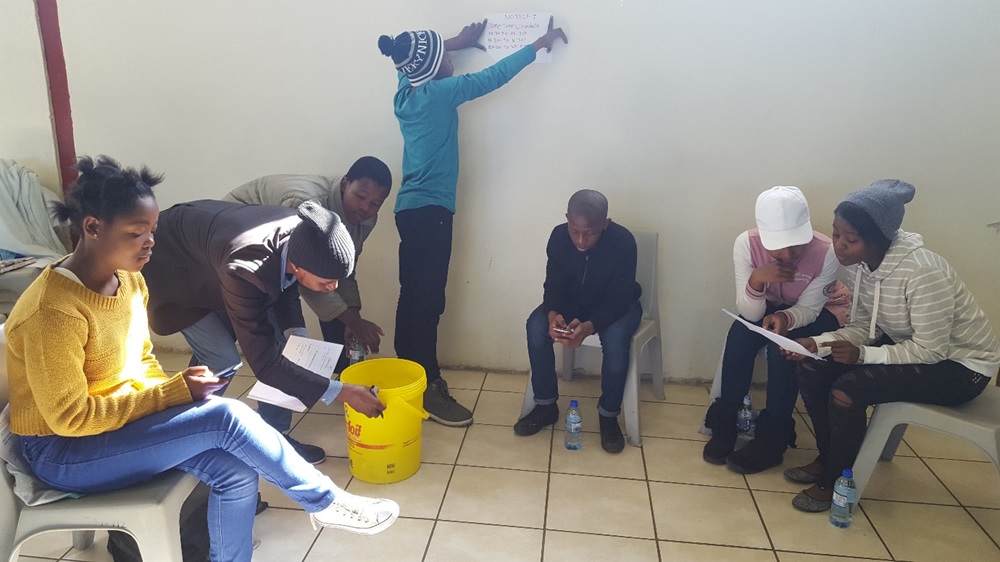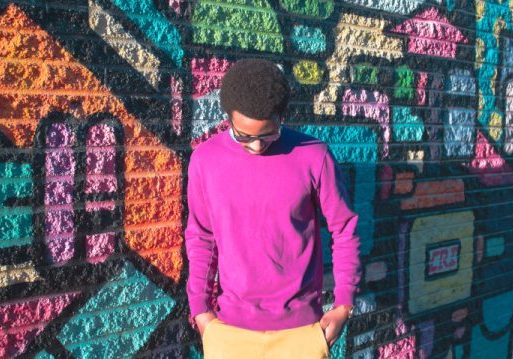Boingboing blogs from… Leandra
Image film-making workshop in Leandra, 24 June 2017
by Simon Duncan, Boingboing Trainer and Project Worker
Hi everyone! It’s Simon here, back at my writing desk, pleased to share with you all the juicy information about the second day of our drought and resilience research in Leandra, in June 2017. I was extremely happy to be given the opportunity to help with the co-research process for Boingboing. So, I packed up my wheelchair and travelled to South Africa alongside two fellow young Boingboingers, Naz and Lisa, who, like me, also have their own histories of complex disadvantage.
This blog follows on directly from Naz’s brilliant blog which will tell you all about the opening day of co-productive research. Feel free to have a read of Naz’s blog and come back to this one. It will give you a good sense of the work the research team and young co-researchers have done in South Africa so far. Anyway, on with this blog!
As the sun rose on Leandra, all members of the research team had two things on their minds, the first being breakfast and the second being our work for the day. Our objective for the second day of co-research was to help facilitate the co-researchers in Leandra, so that they could create active images which convey the different types of social change that would enable them to be more resilient in the face of drought. These active images would then be compiled into film footage, which would be disseminated to policymakers at provincial and national levels. This is in the hope of initiating the creation of a sustainable, long-term youth resilience strategy. I must say, I felt a mix of nervous and excited. I’m sure this feeling was shared with at least some of the Master’s students from the University of Pretoria, because as one person said, ‘they had never done anything like this before.’
We should not have worried though. Just like yesterday, the image film-making process would be directed by Selogadi Mampane. Having seen Selogadi’s Art’s Activist approach in action on home soil earlier in June 2017, I was sure that we would be in safe hands. You can read a previous blog about when Selogadi gave Boingboing a special preview of her Arts Activist approach at a Resilience Forum.
Selogadi began by telling us that we needed to raise the energy level in our bodies in order to become the most creative versions of ourselves. What ensued were some breathing exercises and an intensive cardio session (which some of us were not ready for!). We shook out all of the nervousness, worry and stress from our bodies, progressing from the tips of our toes to the very top of our heads. After being put through our paces by our very own Ms. Motivator, we were asked to get acquainted with our emotions. This was achieved by placing different pieces of paper with emotions written on them, on the floor. For example, anger, fear and joy. We were asked to create a line and journey across the room. As we reached a piece of paper on the floor, we would emote the specified emotion. This allowed all of us in the room to explore the spectrum of emotions and understand how each one can change our body posture, facial expression and mental outlook in different ways. By understanding our emotions better, the emotions of the co-researchers as their characters in the image, should be more pronounced in the final film. Hopefully this will enable policymakers to understand the variety of emotional, physical and social impacts that living in a drought-affected community can have on a young person’s life, when the film is presented to them in October 2017.
Once we were all warmed up and ready to let our artistic sides emerge, we began to lay the groundwork for the film that would be created. We separated into groups, our first task was to create an image based on what happens when a township is told to cope with drought. The young co-researchers could decide to be any character or object that they wanted throughout this process.
In this image, you see a municipal worker presenting strategies to the community about how to save water. The meeting itself is held in the community hall. A child is afraid to ask the municipal worker questions, so he whispers them to his mum in order for her to ask on his behalf. The municipal workers feel powerful, because they are able to help the community. The co-researchers described that there was a large power dynamic between the residents of the township and the municipal workers simply telling the residents what to do, and expecting them to do it, rather than entering into a dialogue about what is achievable in these circumstances.
As we worked through this task and the rest of the day groups were diligently facilitated, and extremely thorough notes were taken for an actor’s journal, in a combined effort by the Master’s students, Lisa and me. This was to ensure as little data loss as possible, because we want the findings from the research to be as rich as possible. Selogadi told us, in no uncertain terms, not to direct the co-researchers. Instead we were to ask questions that would focus the image and make it easier to understand, for those who observed it. An example of a focussing question was: ‘Who is the most powerful person in this scene? How can we show that?’ This way, the co-researchers’ experiences of drought and what makes them resilient to it would be conveyed in a way that truly belonged to them and was realistic, instead of being diluted by us stepping in with our ideas.
We were then asked to create a second image with the question – ‘How could this situation be made better?’ After some discussion and debate, one of the co-researchers swiftly transformed into a jojo truck – a tank which carries water, sent by the municipality worker to help alleviate the demand for water in the community. Students are collecting water. You can see one group’s image below on the left.
The co-researchers immediately said that while this is a good approach and can help reduce the impact of drought temporarily, water is a limited resource. So, more needs to be done. On the right of this image you see a municipal worker warmly greeting young people to ask them gently about whether they are saving water, but also to reassure them that this drought is temporary and rain will eventually come.
As if predicting that the co-researchers would say that more needs to be done to combat drought, Selogadi told us that the third and final image would be based on the question: ‘What would you like to happen if external resources were available to help us counter the impact of drought’. The same group’s third image is here.
The pot in this scene represents a centrally located, well maintained tap that enables the community to get water independently without needing the jojo trucks to come in and provide water. The opening hours for the tap are well publicised and people use social media to get this message out to everyone in the community. Because of the tap, the students do not have to collect the water. As such, they can actually spend more time studying, which should help them to achieve in school and become more resilient in the long run.
Our final objective before filming was to create two transitional scenes that showed the connections between the first and second, and second and third scenes respectively. I won’t tell you anything about that part, just in case you get to see it in the final video!
After this work, all of us were very hungry. Let it never be said that creativity is not intensive work. We stepped out into the sun to allow Selogadi to set up the performance space. The co-researchers were extremely dedicated, even practicing their scenes outside the community centre during their well-earned lunch break.
Soon it was time to perform for the cameras which were led by Selogadi. As the filming process began everyone got a bit nervous. You could sense it in the air. As each group went in to perform, the tension increased. Nonetheless, the co-researchers performed amazingly as expected and produced lots of quality footage, which will be edited and presented in October.
As the different groups went to perform, it was my chance to get in front of the camera, asking the co-researchers about what their experience of being a co-researcher was like, and improvements we could make for next time. After Scott lowered the camera for me, so I would be in the frame, the interviews commenced. Seeing how composed all of the interviewees were in front of the camera, I wouldn’t be surprised if we see them presenting the news one day, or being advocates for their community on a larger stage. Meanwhile, Lisa carried her instant camera, asking the young people if they wanted pictures of themselves and their friends, to remember the experiences they’ve had as a co-researcher. I don’t think anyone said no to her!
After the filming was done, we all gave each other and the film crew a round of applause and gave the co-researchers their vouchers for their work. It was a successful day all round. If I could, I would thank each and every person involved in the co-research process from the people who provided lunch to the many co-researchers; without you the work couldn’t have been a success.
On a personal note, I feel honoured to have been given the opportunity to work with Boingboing as a co-researcher, helping with the co-productive process of countering the impact of drought, particularly coming from a position of complex disadvantage as a wheelchair user who has mental health issues. I’m also very happy to have shared this experience with the immensely talented Lisa and Naz. I can’t wait for our next Boingboing trip!
I leave South Africa hoping that when the policymakers see the co-researchers’ film in October, they really understand the message that the co-researchers are conveying through it, and take it to heart. In my humble opinion, they should utilise it to initiate policy changes which make life better for everyone in drought-affected communities.






